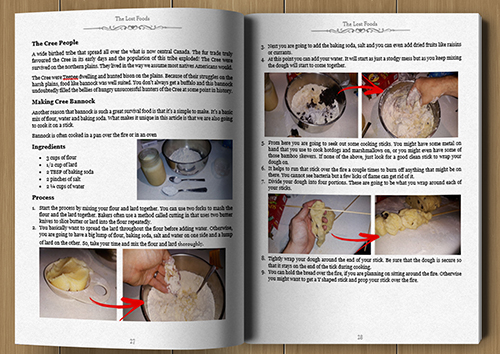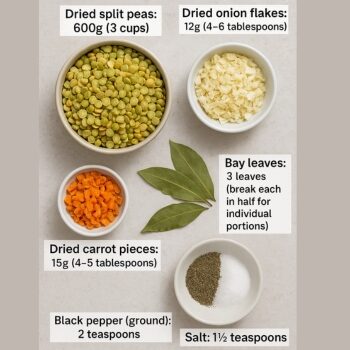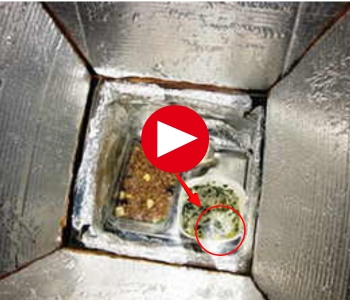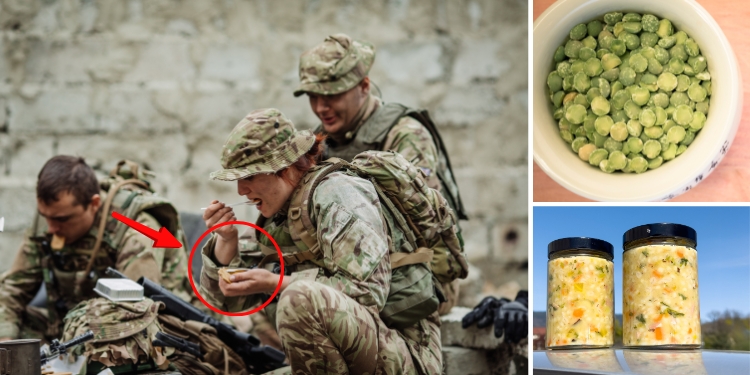When soldiers marched for days on end, facing cold nights, muddy roads, and empty supply lines, they didn’t have the luxury of fresh food. They needed something cheap, simple, and packed with the energy to keep them moving. Their answer was a humble mix of dried peas and seasonings, so durable and nutritious that it kept armies alive for centuries. Today, we call it Soldier’s Pea Soup Mix, and it’s a forgotten survival food that deserves a place in every prepper’s pantry.
Not only is it hearty and filling, but when sealed correctly, it can last up to a decade. And in a crisis, few things are more valuable than a meal that’s already proven itself on the battlefield.
Why Armies Chose Peas as Their Survival Food
Military strategists learned early that feeding soldiers required three non-negotiables: the food had to travel far, last years without spoiling, and provide enough energy to fight. Dried peas delivered on every front.
Swedish pea soup, or ärtsoppa, has roots in medieval times, when it was eaten on Thursdays ahead of Friday fasts. Made from dried yellow peas and simmered slowly, it became a staple of Swedish cuisine for centuries.
During World War II, the Swedish military adopted it as a regular Thursday meal—a tradition that continues today and influenced later military rations.
European armies—particularly the Prussians and French—built entire campaigns around pea soup logistics. Prussia developed compressed “pea bricks” mixed with meat that soldiers could quickly boil into nutritious stew. These became some of history’s first true field rations, proving their worth across muddy battlefields and frozen trenches.
Even through both World Wars, pea soup remained standard issue. German forces carried canned pea-and-bacon soup, while Allied troops survived on basic dried pea mixes cooked in camp kettles. The reason was simple: while other foods spoiled or ran out, peas delivered consistent nutrition year after year.
The lesson for preppers is clear: if this food kept armies operational for over two centuries, it deserves serious consideration for your long-term storage plans.
 This is a recipe that, much like the ANZAC Biscuits, reminds me of the famous long-lasting foods popular in America during the most difficult times of our history.
This is a recipe that, much like the ANZAC Biscuits, reminds me of the famous long-lasting foods popular in America during the most difficult times of our history.
I really like recipes from wartime especially, because they follow three principles that are essential to me as a prepper:
- They are long-lasting
- They are nutritious
- They are cheap
The same principles are, for example, at the foundation of the Doomsday Ration. Developed during the Cold War, this recipe cost no more than $0.37 per day to feed an adult (this can still be done today).
And every single component could be stored for years without any issues! That’s just one example.
In The Lost Superfoods you’ll find over 125 examples of crisis-time recipes that you should seriously consider if you’re making a solid survival plan.
Ingredients for Your Soldier’s Soup Mix
This recipe yields 6 hearty servings that pack perfectly into one quart jar or six individual meal pouches:
 Base ingredients:
Base ingredients:
- Dried split peas: 600g (3 cups)
- Dried onion flakes: 12g (4–6 tablespoons)
- Dried carrot pieces: 15g (4–5 tablespoons)
- Bay leaves: 3 leaves (break each in half for individual portions)
- Black pepper (ground): 2 teaspoons
- Salt: 1½ teaspoons (pack separately to control sodium levels)
Why this combination works: Split peas deliver approximately 25g of protein per serving, plus complex carbohydrates and fiber. Onions and carrots contribute vitamins, minerals, and flavor depth. Keeping salt separate prevents over-seasoning and allows you to adjust sodium intake if water is scarce or you’re adding salty ingredients like smoked meat.
These are all very important ingredients, not only in terms of food longevity, but also when it comes to their ability to provide you with a healthier alternative.
Be very careful with salt, as it can cause thyroid problems. In post-SHTF situations, these issues can quickly get worse…
That’s why it’s smart to prepare a well-thought-out stockpile of medicines (learn here how to do it), especially if you know you’re predisposed to such conditions.
I also recommend complementing any medical treatment—especially when it comes to nutrition-related problems—with natural remedies.
Dr. Nicole Apelian offers simple, practical protocols that you can easily put into practice on your own—even post-SHTF.

Don’t have the plants you need? The solution is this special kit right here. Keep this in mind and your body will thank you, especially if you’re a senior!
Nutritional Power Per Serving
Each 105-110g serving (1/6 of the batch) provides:
- Calories: ~370 kcal
- Protein: ~25g (comparable to a chicken breast)
- Carbohydrates: ~64g
- Fiber: ~26g (more than most people eat in an entire day)
- Fat: ~1.2g
- Sodium: Variable (approximately 600mg if using the optional salt)
This nutritional profile explains why armies chose peas: you get substantial protein, sustained energy from complex carbs, and digestive health from high fiber content.
You can find more protein-packed recipes here, delivered straight to you by a survival expert with decades of experience in the toughest survival conditions.
Cooking Your Soldier’s Soup Mix
Basic Stovetop Method (30-45 minutes)
- Bring 3 cups (720ml) of water to a rolling boil in a medium saucepan
- Add one portion (105-110g) of your soup mix directly to boiling water
- Stir thoroughly to prevent clumping, then reduce heat to medium-low
- Simmer uncovered for 30-45 minutes, stirring every 10 minutes to prevent sticking
- Test doneness: peas should be tender and breaking apart, creating a thick consistency
- Add salt to taste (start with ¼ teaspoon, adjust as needed)
- Let stand 5 minutes before serving to allow thickening
 You can use also use the solar oven method, which is actually similar to this one. You need to use a dark, heavy-bottomed pot with tight lid. Add soup mix and 3-3.5 cups water (more than stovetop due to longer cooking time).
You can use also use the solar oven method, which is actually similar to this one. You need to use a dark, heavy-bottomed pot with tight lid. Add soup mix and 3-3.5 cups water (more than stovetop due to longer cooking time).
Stir well, cover tightly to prevent evaporation, and place in preheated solar oven targeting 250-300°F.
Cook 2-4 hours depending on sun intensity, checking hourly and adding hot water if needed. Peas are done when they break apart and create thick consistency.
Solar cooking works perfectly for pea soup since it needs sustained heat over time rather than precise temperature control, making it ideal for off-grid survival situations. In fact, this method is one of the Amish community’s favorites—true experts when it comes to ingenious off-grid solutions.
You can find recipes suitable for solar ovens, as well as instructions on how to build your own solar oven, in The Amish Ways Book.
Pressure Cooker Method (8-10 minutes)
- Add soup mix and 3 cups water to pressure cooker
- Cook at high pressure for 8 minutes
- Allow natural pressure release for 10 minutes
- Quick-release remaining pressure and check consistency
- If too thin, simmer uncovered for 5 minutes to reduce
Thermos Cooking Method (Ideal for Bug-Out)
- Preheat wide-mouth thermos with boiling water for 5 minutes
- Empty thermos and immediately add soup mix
- Pour in boiling water, leaving 1-inch headspace
- Seal tightly and wrap in towel or sleeping bag
- Let cook 3-4 hours while traveling
- Result: hot, ready-to-eat soup with no additional fuel needed
Troubleshooting Common Issues:
Soup too thin: Simmer uncovered to reduce liquid, or mash some peas against pot sides
Peas won’t soften: Older peas need longer cooking; try pressure cooking or overnight soaking
Sticking to pot: Use heavier-bottomed pan and stir more frequently
Upgrading The Basic Recipe
While soldiers had limited options, you can enhance both nutrition and morale:
Protein boosters:
Dehydrated ham or smoked sausage chunks
Freeze-dried chicken or beef pieces
Flavor enhancers:
Dried herbs: thyme, parsley, rosemary
Spices: garlic powder, paprika, chili flakes
Vegetable additions:
Dehydrated potatoes for extra carbs
Dried celery or leeks for complexity
Strategic approach: Maintain bulk supplies of basic mix for reliability, plus smaller enhanced batches for morale. Hot, flavorful soup feeds both body and spirit during difficult times.
Storage Instructions for Maximum Shelf Life
 Step 1: Mix Your Base Ingredients
Step 1: Mix Your Base Ingredients
Combine 600g split peas, 12g onion flakes, 15g dried carrot, and 2 teaspoons black pepper in a large bowl. Break bay leaves in half and distribute evenly.
Step 2: Portion for Convenience
Divide the mix into 6 individual portions of 105-110g each. Add one bay leaf half to each portion. This approach gives you grab-and-go meals without opening your entire supply.
Step 3: Choose Your Storage Method
Mylar pouches: Use 5-7 mil thickness, pint-size for single servings or quart-size for the full batch
Mason jars: One quart jar accommodates the complete recipe perfectly
Step 4: Add Oxygen Absorbers and Seal
Single servings (pint Mylar): Use 100-150cc oxygen absorber per pouch
Full batch (quart container): Use 300-500cc oxygen absorber
Heat-seal Mylar pouches; for jars, ensure clean rims and use new lids
Step 5: Store Strategically
Store containers in cool, dark, dry locations (50-70°F ideal). Avoid temperature fluctuations and any moisture exposure. Place sealed pouches inside rodent-proof containers for long-term storage.
Quality verification: Properly sealed Mylar pouches should feel firm and flattened within 24 hours as oxygen absorbers activate. Mason jar lids should show slight center depression.
Why This Belongs in Every Prepper’s Pantry
 Consider why Soldier’s Pea Soup Mix deserves priority in your food storage:
Consider why Soldier’s Pea Soup Mix deserves priority in your food storage:
- Historical proof: Two centuries of military use validates its survival effectiveness.
- Economic sense: Bulk dried peas cost pennies compared to commercial survival meals.
- Longevity: Proper storage yields 5-10 years of reliable nutrition.
- Nutritional density: Complete protein, sustained energy, essential minerals in one bowl.
- Cooking flexibility: Requires only water and heat source.
- Psychological benefit: Hot, hearty soup provides comfort during crisis periods.
When store shelves stay bare, you need more than snack foods and quick fixes. You need nutrition proven to sustain people through history’s harshest conditions. Soldier’s Pea Soup Mix is basically tested insurance for your family’s survival.
Start with one batch. Test the cooking process. Taste the results. Once you experience the satisfaction of this centuries-proven meal, you’ll understand why smart preppers make it a cornerstone of their long-term food storage strategy.
Final Thoughts
Every serious prepper faces the same challenge: building food storage that actually works when everything else fails. You can stockpile all the freeze-dried meals and MREs you want, but when your budget runs thin or supply chains collapse entirely, I believe you need foods that armies have trusted for generations.
Soldier’s Pea Soup Mix represents the intersection of history, nutrition, and practicality. It’s not glamorous, but neither was surviving the trenches of World War I or marching across frozen battlefields. What matters is that it works—reliably, affordably, and indefinitely when stored properly.
The next time you’re building your food storage budget, ask yourself this: would you rather have six expensive freeze-dried meals that last five years, or sixty servings of proven soldier’s soup that costs the same and stores for a decade? The math speaks for itself.
More importantly, this recipe connects you to generations of survivors who understood a fundamental truth: in crisis, simple foods prepared well beat complex solutions that might fail. Your great-grandfather’s generation knew this. Armies worldwide proved it repeatedly. Now it’s your turn to add this time-tested insurance to your family’s survival plan.
Mix a batch this weekend. Your future self will thank you.
No recipe like the one presented can be prepared without quality water. I recommend using the same solutions I rely on myself: The Water Freedom System, based on declassified U.S. Army plans, as well as this ingenious portable water generator, which you can also take to your bug-out location. Be smart and secure your survival with minimal effort.
You may also like:

Stop Ignoring These Long-Lasting Protein Sources
The Most Powerful Survival Food You Can Make At Home (20+ Years Shelf Life) (Video)
7 Food Preservation Methods From The Bible You Can Still Use Today
35 Foods That Can Last a Century
The 10 Cooking Mistakes That Might Kill You
Read the full article here



